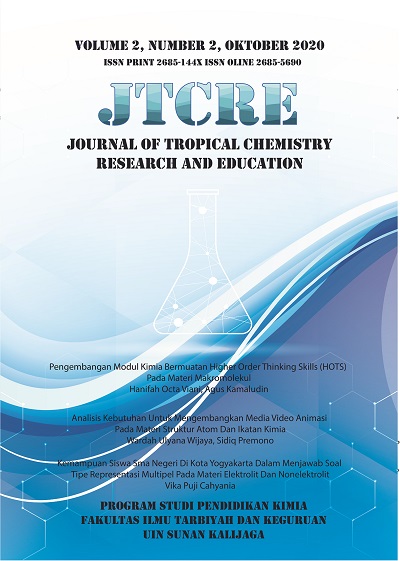Kemampuan Siswa Sma Negeri Di Kota Yogyakarta Dalam Menjawab Soal Tipe Representasi Multipel Pada Materi Elektrolit Dan Nonelektrolit
DOI:
https://doi.org/10.14421/jtcre.2020.22-03Keywords:
Deskriptif kuantitatif, Elektrolit dan non elektrolit, Kemampuan siswa, representasi multipleAbstract
Elektrolit dan nonelektrolit adalah salah satu materi mata pelajaran kimia SMA yang di ajarkan di kelas X yang terdiri dari representasi makroskopik, mikroskopis, simbolik dan matematika. Siswa mengalami kesulitan dalam memahami konten dalam elektrolit dan non-elektrolit dalam perspektif representasi multipel. Penelitian ini bertujuan untuk menganalisis kemampuan siswa sekolah menengah dalam menjawab soal pilihan ganda berbentuk representasi multipel pada materi elektrolit dan non-elektrolit, untuk menganalisis aspek representasi yang memiliki persentase terendah di antara aspek-aspek lainnya. Penelitian ini adalah penelitian deskriptif kuantitatif. Subjek yang dilibatkan sebanyak 394 siswa kelas X yang berasal dari tiga sekolah menengah di kota Yogyakarta. Teknik sampling yang dipilih menggunakan teknik stratified purposive sampling karena mewakili sekolah tingkat rendah, menengah, dan tinggi. Instrumen representasi multipel terdiri dari 37 item pilihan ganda yang mencakup aspek makroskopis, mikroskopis, simbolik, dan matematika. Tes diberikan pada akhir proses pembelajaran. Analisis data penelitian ini menggunakan model Rasch untuk menganalisis kemampuan siswa, kriteria penilaian ideal untuk mengkategorikan kemampuan siswa serta ANAVA satu jalur untuk mengetahui apakah ada perbedaan yang signifikan antara skor rata-rata sekolah strata tinggi, sedang dan rendah. Temuan penelitian mengungkapkan bahwa kemampuan representasi multipel siswa pada materi elektrolit dan non-elektrolit diklasifikasikan dalam kategori tinggi. Aspek representasi yang memiliki persentase kemampuan terendah di antara aspek-aspek lainnya adalah aspek simbolik.
Downloads
References
Ainsworth, S. (1999). The functions of multiple representations. Computers & Education, 33(2-3), 131-152.
Chandrasegaran, A. L., Treagust, D.F., & Mocerino, M. (2007). The development of a two-tier multiple-choice diagnostic instrument for evaluating secondary school students’ ability to describe and explain chemical reactions using multiple levels of representation. Chemistry Education Research and Practice, 8(3), 293-307.
Demircioglu, G., Demircioglu, H., & Yadigaroglu, M. (2013). An investigation of chemistry student teachers’ understanding of chemical equilibrium. International Journal on New Trends in Education and Their Implications, 4(2), 185-192.
Felder, R.M., & Brent, R. (2005). Understanding student differences. Journal of Engineering Education, 94(1), 57-72.
Gabel, D. (1999). Improving teaching and learning through chemistry education research: A look to the future. Journal of Chemical Education, 76(4), 548-554.
Gilbert, J.K., & Treagust, D. (2009). Models and modeling in science education: Multiple representations in chemical education. Perth: Springer.
Griffiths, A.K., & Preston, K.R. (1992). Grade-12 students’ misconceptions relating to fundamental characteristics of atoms and molecules. Journal of Research in Science Teaching, 29(6), 611-628.
Hernandez, G.E., Criswell, B.A., Kirk, N.J., Sauder, D.G., & Rushton, G.T. (2014). Pushing for particulate level models of adiabatic and isothermal processes in upper-level chemistry courses: a qualitative study. Chemistry Education Research and Practice, 15, 354-365.
Johnstone, A.H. (1993). The development of chemistry teaching a changing response to changing demand. The Forum Symposium on Revolution and Evolution in Chemical Education, 70(9), 701-705.
Johnstone, A.H. (2000). Teaching of chemistry-logical or psychological?. Chemistry Education: Research and Practice in Europe, 1(1), 9-15.
Kamila, A., Fadiawati, N., & Tania, L. (2017). Efektivitas buku siswa larutan penyangga berbasis representasi kimia dalam meningkatkan pemahaman konsep. Jurnal Pendidikan dan Pembelajaran Kimia, 7(2), 211-222.
Keig, P. F., & Rubba, P.A. (1993). Translation of representations of the structure of matter and its relationship to reasoning, gender, spatial reasoning, and specific prior knowledge. Journal of Research in Science Teaching, 30(8), 883-903.
Milenkovic, D.D., Segedinac, M.D., & Hrin, T.N. (2014). Increasing high school students’ chemistry performance and reducing cognitive load through an instructional strategy based on the interaction of multiple levels of knowledge representation. Journal of Chemical Education, A-H.
Nakhleh, M.B., & Krajcik, J.S. (1994). Influence of levels of information as presented by different technologies on students’ understanding of acid, base, and pH concepts. Journal of Research in Science Teaching, 31(10), 1077-1096.
Sutamiati, K., Sunyono, & Efkar, T. (2015). LKS berbasis multipel representasi menggunakan model simayang pada materi larutan asam basa. Jurnal Pendidikan dan Pembelajaran Kimia, 4(1), 275-286.
Talanquer, V. (2011). Macro, submicro, and symbolic: The many faces of the chemistry “triplet”'. International Journal of Science Education, 33(2), 179-195.
Thomas, G.P. (2017). ‘Triangulation’: An expression for stimulating metacognitive reflection regarding the use of ‘triplet’ representations for chemistry learning. Chemistry Education Research and Practice, 18(4), 1-48.
Wu, H.K., Krajcik, J.S., & Soloway, E. (2001). Promoting Understanding of Chemical Representations: Students' Use of a Visualization Tool in the Classroom. Journal of Research In Science Teaching, 38(7), 821-842.
Wu, H.K., & Shah, P. 2003. Exploring visuospatial thinking in chemistry learning. Science Education, 88(3), 465-492.











